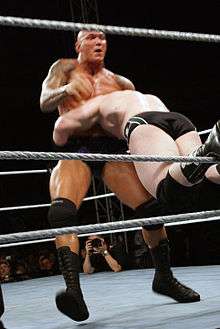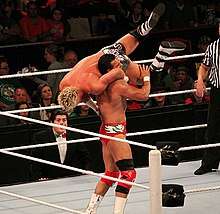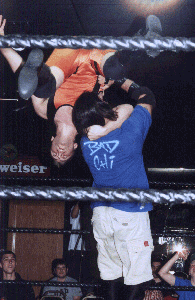DDT (professional wrestling)
In professional wrestling a DDT is any move in which the wrestler has the opponent in a front facelock/inverted headlock, and falls down or backwards to drive the opponent's head into the mat. The classic DDT is performed by putting the opponent in a front facelock and falling backwards so that the opponent is forced to dive forward onto their head.[1] Although widely credited as an invention of Jake Roberts, who gave the DDT its famous name, the earliest known practitioner of the move was Mexican wrestler Black Gordman, who frequently performed it during the 1970s.[2][3]

Rumors abound as to what the letters DDT supposedly stood for, including Damien's Death Trap, Damien's Death Touch, Damien's Dinner Time (all named after Jake's pet python, Damien), Drape Drop Takedown, Drop Down Town and Death Drop Technique. When asked what DDT meant, Jake once famously replied "The End."[4] The abbreviation itself originally came from the chemical dichlorodiphenyltrichloroethane, a notorious pesticide, as stated during shoot interviews and Jake's Pick Your Poison DVD.
Variations
Front facelock variants
Argentine DDT
The wrestler lifts the opponent onto his shoulders as in an Argentine backbreaker rack, pushes the opponent's legs while still holding the front facelock, flipping them over to the front of the wrestler. The wrestler falls down to the mat front first, driving the opponent face first down to the mat.
The Move was innovated by Kenta Kobashi.
Armbar DDT
Also called a single arm DDT, this variation of the armbreaker involves the attacking wrestler grabbing the opponent's left or right arm, holding it across their chest and then falling backwards, dropping the opponent face first as well as damaging the opponent's arm and shoulder.
Cradle DDT

The wrestler applies a front facelock to the opponent, then lifts the opponent into an elevated leg-trap bodyscissors position and finally fall backwards driving the opponent head first down to the mat. WWE wrestler Paige uses this variation as a finishing move called the Ram-Paige. A variation, known as a hammerlock cradle DDT, involves the attacking wrestler lifting the opponent into a bearhug, applying a hammerlock, then a front facelock, then finally driving the opponent's head into the mat. British wrestler Joseph Conners uses this variation, known as the Righteous Kill and Nia Jax has been utilizing a version of the move since her return from injury.
Double underhook DDT

Innovated by Kenta Kobashi. Instead of applying a head or facelock, the wrestler bends his opponent forward and hooks each arm behind the opponent's head, a position known as a butterfly. The wrestler then tucks the opponent's head under one of his arms and falls back to pull the opponent down either flat on his face, which is the more common variant, or onto the top of their head, causing them to roll over like in a regular DDT. It is also known as a double arm DDT or a butterfly DDT. Mick Foley, Stevie Richards, Drew McIntyre, and Jon Moxley have all popularized variations of this DDT: Foley used an unnamed jumping version, Richards uses a lifting version he calls the Stevie-T, McIntyre used a snap version called the Future Shock, and Moxley uses a lift-and-snap version called the Paradigm Shift or the Death Rider.
Diving DDT
The wrestler stands in an elevated position (usually the top rope) and faces the standing or bent-over opponent. As they dive, the wrestler wraps their near arm around the opponent's head in a front facelock and swings themselves backwards in midair, landing back-first and simultaneously forcing the opponent's head into the mat.It's used by Orange Cassidy.
Elevated DDT

This version of a DDT first sees an attacking wrestler place the opponent on an elevated surface, usually the ropes or the turnbuckle, while applying a front facelock. The attacking wrestler next draws the opponent away from the elevated surface leaving the opponent's feet over the elevated surface (i.e. ring ropes), making them the only thing other than the wrestler keeping the opponent off the ground. The attacking wrestler then falls backwards so that the opponent is forced to dive forward onto their head with extra force due to the height of which they were dropped. This can also be performed as a double team move. A slight variation, known as a diving DDT or a Halo DDT, exists and sees the wrestler and the opponent both on an elevated surface, albeit with the wrestler facing the ring. With the opponent in the front facelock, the wrestler and the opponent both dive off the elevated surface, resulting in the wrestler falling forward to perform the DDT instead of falling backwards. The move is sometimes referred to as a spike DDT, because the defending wrestler lands in an upside-down, almost completely vertical position (known as the "spiked" position, which refers to when a wrestler is actually dropped vertically upside down). This move is usually performed with the defending wrestler's feet on the middle rope, sometimes to an opponent attempting to enter the ring .Tommaso Ciampa uses this move he calls it "willows bell".
Facebreaker DDT
The wrestler applies a front facelock and then falls backwards, much like a normal DDT, but instead of the opponent's head impacting the mat, the wrestler falls to a kneeling or sitting position driving the face of the opponent on to their knee.
Flip DDT
Also known as a front flip DDT. After applying a front facelock, the wrestler pushes off the mat with their legs to flip the opponent and drive them onto the top of their head in a manner similar to the flip piledriver.
Flip-over DDT
Also known as a Samurai Driver, this DDT sees a wrestler place their head between the thighs of an opponent before jumping up while pushing away from the opponent's thighs to flip up and sit on the shoulders of the opponent. The wrestler then spreads their legs, dropping off the opponent's shoulders as they grab hold of the opponent's head in a front facelock to fall down to the mat back first, driving the opponent's head down to the mat. This move sees the attacking wrestler get lifted in a powerbomb position so often this move is used as a counter to a powerbomb.
Float-over DDT
This DDT sees the wrestler stand in front of his opponent facing at him, duck, hook one of his arms over the opponent's shoulder (if it's the opponent's left shoulder that the attacker chooses to seize, he hooks with his right, or opposite if sides are reversed), swing himself under the opponent's armpit then around and over the opponent's back so that he faces the same way as the opponent, lock the opponent's head under his other hand's armpit, spin another 180° to end up having the opponent locked in a front facelock and fall back to drive the opponent skull first to the mat, as in a regular DDT. The maneuver is usually performed after the attacker ducks a punch or a clothesline.
Flowing DDT
A variant of the DDT popularized by Raven, the attacking wrestler would kick the opponent in the stomach before applying a front facelock and falls backwards to drive the opponent's head into the mat.
Fireman's carry DDT
Also described as a fireman's carry implant DDT, this move sees the attacking wrestler first put an opponent up in the fireman's carry (across the wrestler's shoulders) position, then throw the opponent's legs out in front of him/her to spin them out while the attacking wrestler switches the position of their arm that's holding the opponent's head to a front facelock and falls backwards to drive the top of the opponent's head into the mat.
Fisherman DDT
After applying a front facelock, the wrestler hooks the opponent's near leg with his other arm, slightly hoists him up and falls backwards on to his back, driving the opponent's head down to the mat.
Headscissors DDT
Very different from a classic or traditional DDT, as the wrestler never uses his hand in this variation. The wrestler catches the opponent in a standing headscissors, and then falls backwards, slamming the opponent into the mat face-first.
Also often referred to as the Hurricanrana Driver .
Hammerlock DDT
Variation of a classic DDT in which wrestler first applies a hammerlock on the opponent's further arm, then goes for a front facelock, and then falls backwards on to his back, driving the opponent's head down to the mat. Andrade uses this move as a finisher he calls “La Sombra”. Tessa Blanchard also uses a variant of the move.

Jumping DDT
A slight variation where instead of just falling backwards, the wrestler jumps up while holding the front facelock and then uses the weight and momentum to pull the opponent down on their head. Also, a variation of this move is sometimes seen where, as the wrestler jumps, they use the horizontal position to execute a front dropkick to the knees of the opponent to add additional impact to the move.
Legsweep DDT
Also known as the Russian legsweep DDT. In these versions of a DDT the wrestler applies a front facelock and then performs a type of legsweep to essentially take out the legs from under the opponent before falling backwards to drive the opponent face first down to the mat.
Lifting DDT
This version of a DDT is similar to a spike DDT and is often referred to as a low angle brainbuster, or simply as an implant DDT. The attacking wrestler applies a front facelock to an opponent then lifts the opponent off the ground just before falling backwards to drive the opponent face or head first down to the mat. A slight variation of this sees the wrestler spin the opponent's body away from themselves as they raise the opponent off the ground. Another version, the lifting inverted DDT, sees the wrestler apply an inverted facelock, lift the opponent off the ground and fall back. This move was popularized by Gangrel during his stint in WWE as his finishing move, calling it the Impaler DDT, and was later adopted by Edge, who called it the Edgecution. It is now currently performed by Robert Roode who uses a swinging variation as a finishing move, calling it the Glorious DDT.
Moonwalk DDT
With the opponent placed in a front facelock, the attacking wrestler performs a Moonwalk maneuver across the ring and then proceeds to execute a classic DDT slam.
Over the shoulder DDT
The attacking wrestler puts the opponent over the shoulder as in a powerslam set up but instead throws them off and around their body grabbing their head and executing a modified DDT or a modified facebuster.
Running DDT
The wrestler charges at a bent-forward opponent and applies a front facelock before dropping backwards to drive the opponent down to the mat head first. In another variation the wrestler will also push the opponent up with his free arm, performing a spike DDT version of the move.
Scissored DDT
This move sees the wrestler apply the front facelock and then put one of their legs on one of the opponent's arms before falling backward and driving the opponent head first to the mat.
Shooting star DDT
The opponent is facing the wrestler on the turnbuckle. The wrestler then does a backflip towards the opponent catching the opponent into a DDT on the way down.
Single underhook DDT
The wrestler places the opponent in a front facelock and hooks only one of the opponent's arms behind their neck, as if going for a suplex, before falling back and driving the opponent's head into the mat. A variation of this move sees the wrestler lift the opponent off the ground after applying the underhook, before falling back to drive the opponent head first down to the mat. This lifting variation was popularized by Prince Devitt, who used it as a finisher under the name of Bloody Sunday and the 1916 as Finn Bálor.
Slingshot DDT
The wrestler stands on the ring apron and performs a slingshot, and as they pull themselves over the top rope, they grab their opponent in a front facelock and fall backwards, driving their opponent's head into the mat. Johnny Gargano uses it as the One Final Beat.
Snap DDT
The wrestler applies a front facelock to their opponent. The wrestler then jumps down onto their back, swinging their legs forward, bending the opponent, and driving them down to the mat face, forehead, or head first. A slight variation sees the wrestler draw one of their legs backwards (usually the leg closest to the opponent) before swinging it forward to build extra momentum. They then drop onto their back, driving the opponent head first to the mat. Yujiro Takahashi performs a variation where he delivers the DDT to a kneeling opponent, calling his version Pimp Juice.Maryse Mizanin uses this move called "french Kiss'.Alexa Bliss uses it and calls it 'Bliss DDT'.
Spike DDT
The wrestler applies a front facelock to his opponent and lifts them up with his free arm. He then falls backwards, driving the opponent vertically down to the mat head first. The Spike DDT is a version of the DDT which is somewhere between a lifting DDT and a brainbuster.
Tilt-a-whirl DDT
This variation sees the charging wrestler being spun into a tilt-a-whirl and ends the move up into a DDT. An inverted variation is also possible.
Tornado DDT
The tornado DDT is also referred to as a swinging/spinning DDT. A wrestler goes to the top rope and applies a front facelock to an opponent from an elevated position (for example, sitting on the top turnbuckle against an opponent standing on the mat, or from the apron against an opponent standing on the ground). The wrestler then jumps forward and swings around to fall backwards and drop the opponent's head into the mat.
Standing tornado DDT
In this version the fighter charges an opponent standing, jumps and applies the front facelock in the air before swinging and falling backwards having the opponent hit face first or head first into the canvas. This is sometimes known as a jumping swinging DDT and is used regularly by fighters who use a standard tornado DDT. Mickie James popularized this move under the name Mickie-DT.
Vertical suplex DDT
The wrestler applies a front facelock and lifts the opponent up into a vertical suplex and falls back driving the opponent head first into the mat. Also known as the "brain buster"
Inverted facelock variants
This subsection lists DDTs that involve the opponent being dropped on the back of their heads. The basic inverted DDT is also known as an inverted DDT.
Inverted DDT
Commonly known as the reverse DDT. A wrestler applies an inverted facelock to his opponent, then falls backward driving the back of the opponent's head into the mat. The move was popularized by Sting in the late 1990s after he adopted it as his new finisher and named it the Scorpion Death Drop.
Falling inverted DDT
A wrestler applies an inverted facelock. Then the attacker throws his own feet backwards, falling onto his own stomach. The defending wrestler has the back of his head driven into the mat. Popularized by Christian Cage.
Half nelson inverted DDT
The attacking wrestler applies an Inverted facelock and puts his arm under the opponent arm completing the half nelson and drops down with the opponent's head driven into the mat
Lifting inverted DDT
The wrestler applies an inverted facelock on the opponent with one arm, and lifts the opponent up with the other. The wrestler then falls backwards down onto their back, slightly to their side, driving the opponent down to the mat upper back and head first. This move is sometimes incorrectly referred to as an inverted DDT or a reverse DDT. Another variation used can be done where the wrestler falls on their stomach instead of their back, which is known as a lifting falling inverted DDT. Dustin Rhodes uses this move as the Curtain Call.
Shiranui

Also known as a springboard backflip three-quarter facelock inverted DDT. A wrestler puts the opponent into a ¾ facelock, then runs up the corner turnbuckles or ring ropes and jump backwards performing a backflip, and landing face down driving the opponent down to the mat back-first. Sometimes a standing variant is performed by wrestlers with adequate leaping ability or when assisted by a tag team partner. The move is popularly known, especially in North America, as Sliced Bread No. 2, a name created by wrestler Brian Kendrick.[5][6] In a slight variation named sitout shiranui the wrestler lands into a seated position instead, driving the opponent's head between the legs.
Snap inverted DDT
A wrestler applies an inverted facelock to the opponent, swings either his or her legs for momentum and then falls backward driving the back of the opponent's head into the mat.
Standing shiranui

Also known as a backflip three-quarter facelock inverted DDT. In this move a wrestler applies a three-quarter facelock on the opponent and performs a backflip over the opponent while maintaining the facelock turning it into an inverted facelock and then either landing face down to the mat, on their own back to the side, on their knees, or in a sitting position, to drive the opponent's head back-first down to the mat. This move has several names, usually depending on the person performing it. The official name of the move used to be the "Asai DDT" as it was innovated by Yoshihiro Asai (Último Dragón). A sitout variation is also used.
NJPW wrestler Tetsuya Naito uses a modified version of this move called the Destino which sees him grabbing and underhooking an opponent's single right arm with his right arm from behind while reaching under the outstretched right arm to take hold the opponent's head with his left arm while running a few short steps forward to jump performing while a backflip maintaining his hold on his opponent thus executing the maneuver.
Swinging inverted DDT
This variation sees a wrestler lock in a front facelock and, while falling backwards, twist their opponent around resulting in the opponent landing on the back of their head, as in a standing inverted DDT. The same technique can be used to end in a falling inverted DDT. A slight variation of this sees the wrestler reach under the opponent while setting up the move to grab their far arm. From there, the wrestler pulls the arm over, causing the opponent to twist around until they are in an inverted facelock before then dropping backwards for a standard inverted DDT.
Tilt-a-whirl inverted DDT
Similar to the normal tilt-a-whirl DDT. This DDT sees the charging wrestler being tilt-a-whirled by the opponent, after the maneuver is over, the wrestler holds the opponent into an inverted facelock, and then falling backwards while he's elevated off the mat into an inverted DDT.
Tornado inverted DDT
The attacking wrestler applies an inverted facelock from an elevated position (for example, sitting on the top turnbuckle against an opponent standing on the mat, or from the apron against an opponent standing on the ground). He/she then jumps off so that he/she swings around the opponent. Using the momentum from the jump, he/she falls forwards and slams the back of the opponent's head into the mat. A standing jumping reverse tornado version of the move is also possible.
See also
References
- WWE (July 2007), WWE Magazine (p.23), World Wrestling Entertainment
- "the 50 coolest maneuvers of all time - DDT". WWE. 2014-02-21. Retrieved 2014-03-13.
- Rims, Rock. "Black Gordman". SoCalUncensored. Archived from the original on 29 September 2019. Retrieved 15 November 2015.
- "WWE and Pro Wrestling Iconic Moves, Part 3: The DDT". bleacherreport.com. Retrieved 13 December 2015.
- "The Brian Kendrick Bio". World Wrestling Entertainment. Archived from the original on 2009-06-02. Retrieved 2009-04-15.
- "the 50 coolest maneuvers of all time". WWE. 2014-02-21. Retrieved 2014-05-04.
